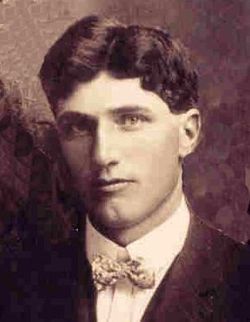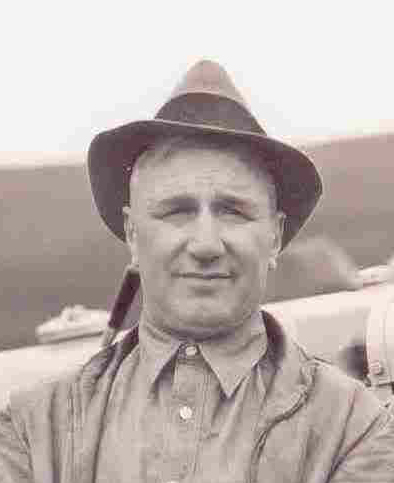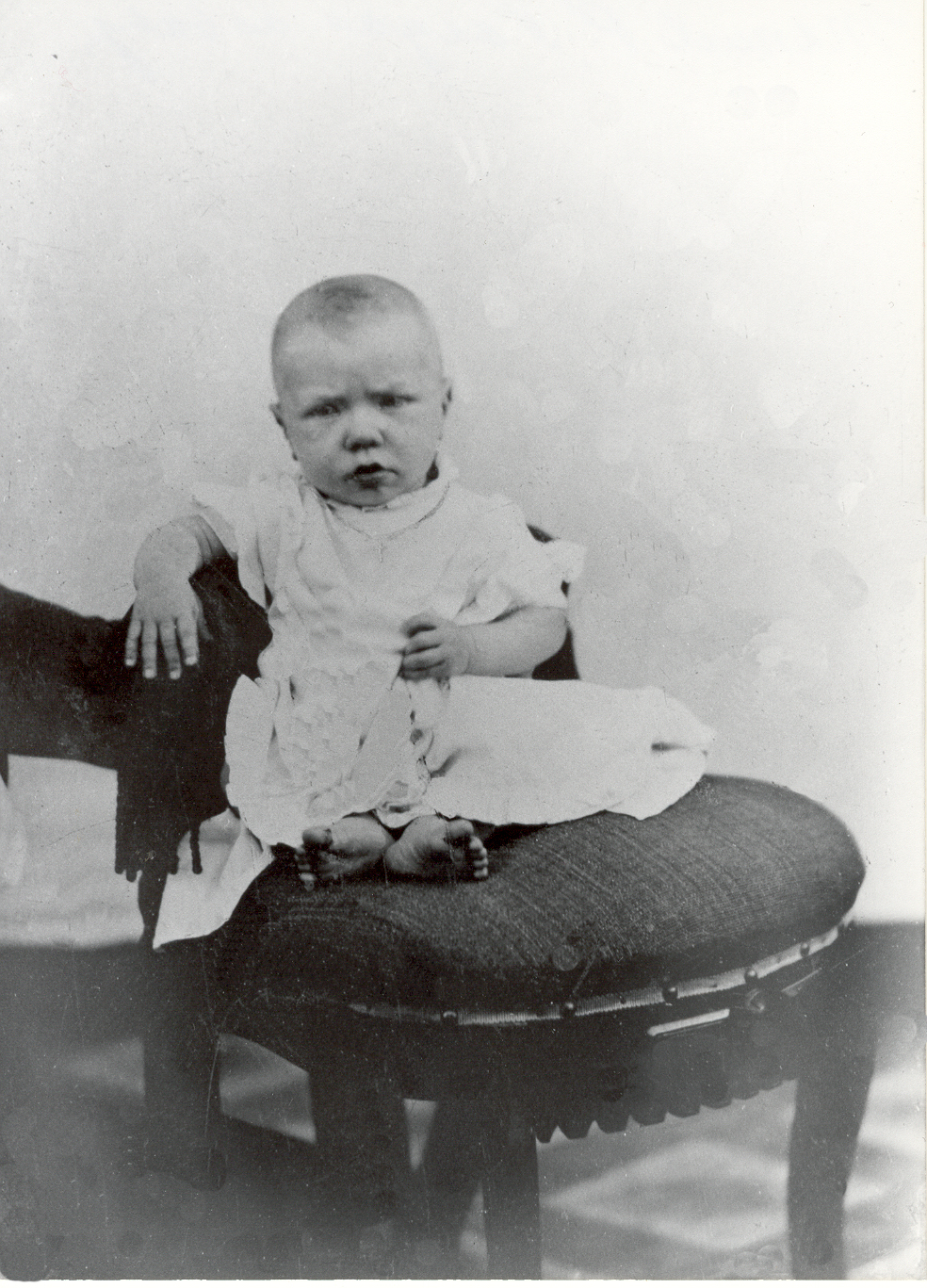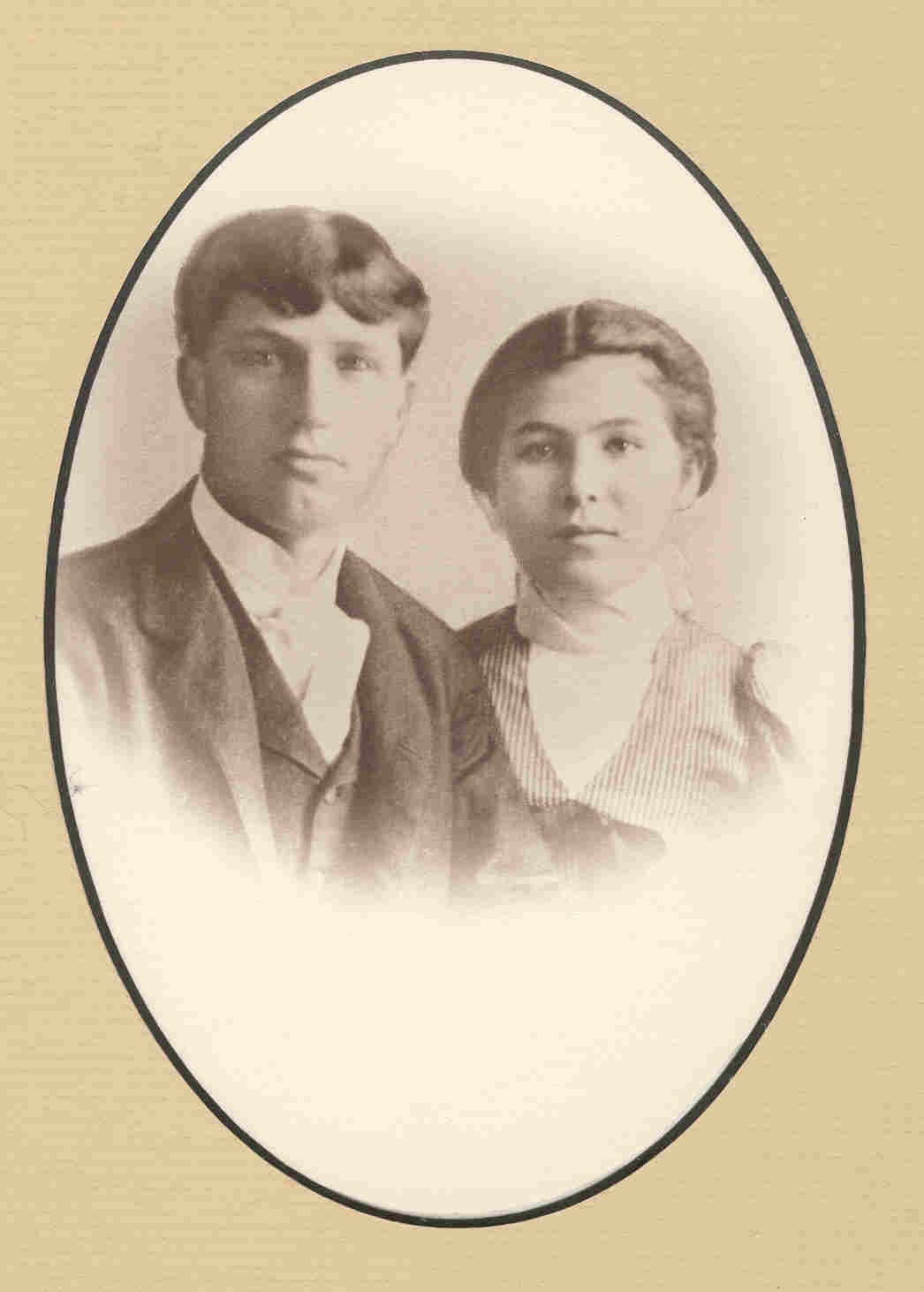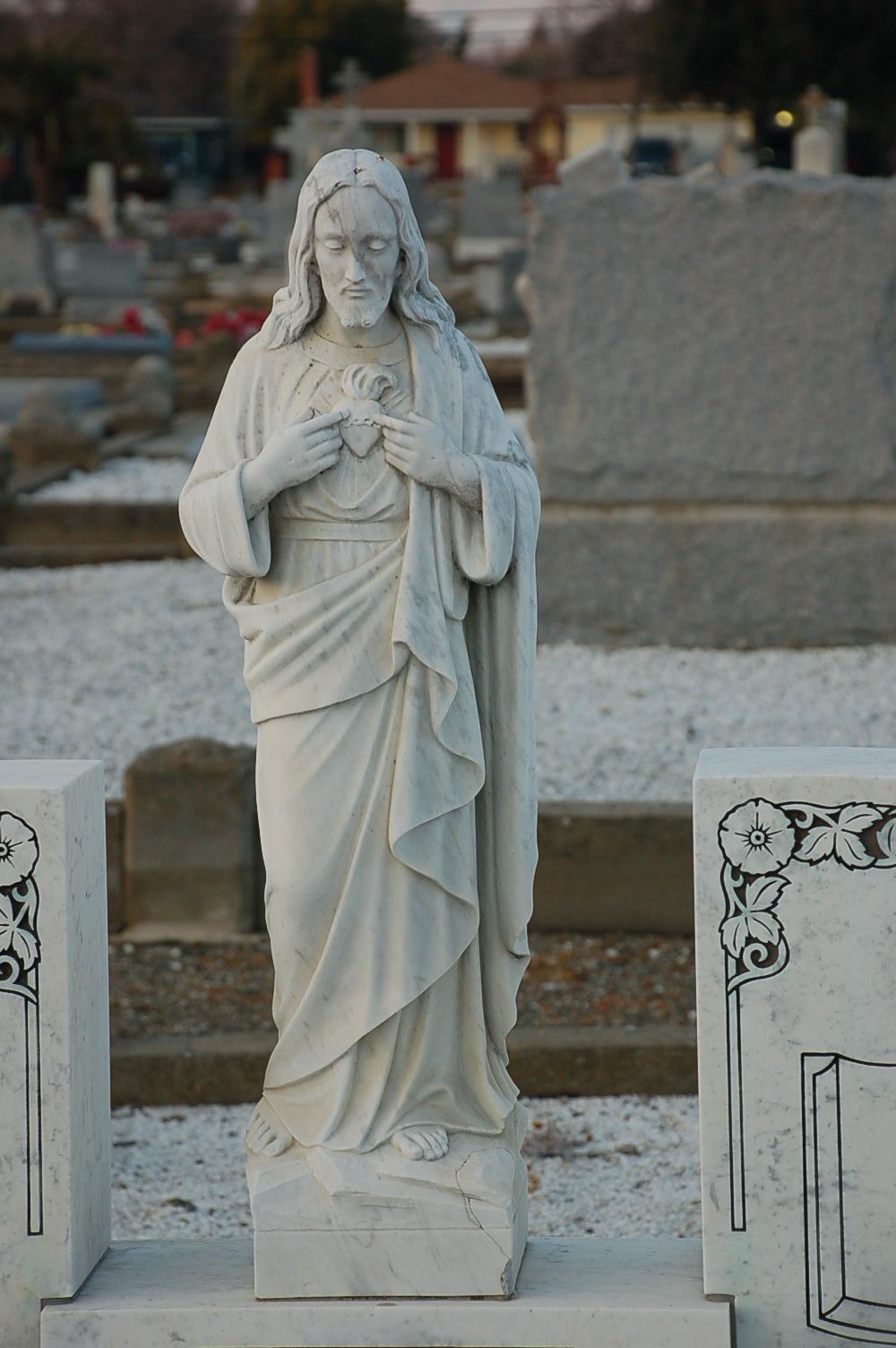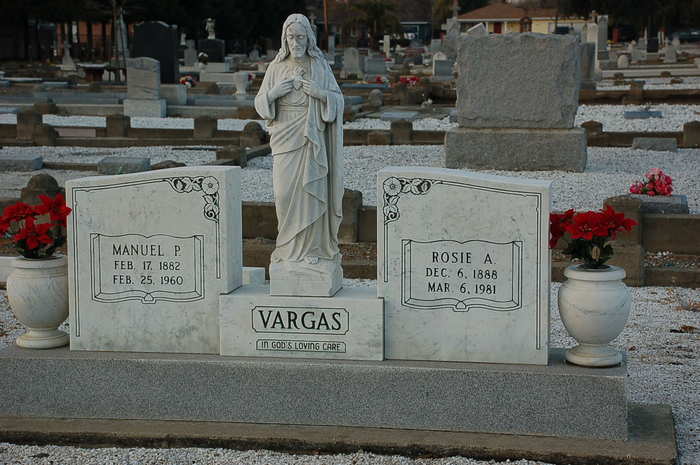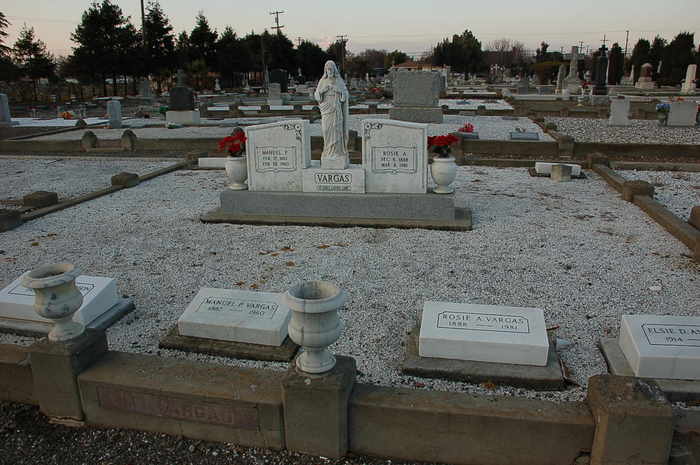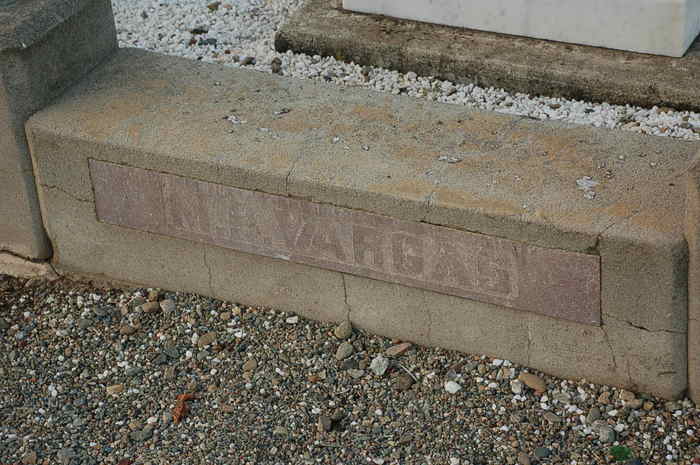Manuel Pereira Vargas was born on February 9, 1882 in the Lombega area of Castelo Branco, Faial, to Antonio Pereira Vargas and Anna Luiza Silva. He was the second child and oldest son of eleven children: Maria (1880-1897), Manuel (1882-1960), Luiza (1884-1958), Jose (1886-1956), Antonio (1889-1961), Francisco (1891-1979), Serefino (1893-19??), Albino (1895-1897), Maria (1897-1991), Anna (1902-1981) and Albino (1903-1992). All of these children came to California with the exception of Serefino and Anna and two children who died young, the first Maria and Albino.
Manuel had the opportunity to come to California with his father's brother, Frank Prada/Pereira Vargas, who came back to visit Faial from California in 1891. Manuel left Faial at the age of nine, urged by his parents hopes for a better life in America. He came on the S.S. Vega, arriving in New York on July 11, 1891. He joined a household of five cousins, Mary 12, Louise 10, Frank 8, Minnie 4 and Rosie 3. Another cousin, Margaret, was born the next year. Manuel and his cousins attended Warm Springs School. Unable to speak English, his adjustment to school was not an easy one. He was able to memorize well and, on one occasion, when asked to read aloud in class, he proceeded to do it with the book closed. The teacher did not approve of his unorthodox performance and reprimanded him. Manuel often spoke of this incident as a grown man. He soon decided to leave school and completed only the second or third grade.
Manuel grew up to be a very handsome young man, six feet tall, with blue eyes and a distinctive cleft in his chin. Before he married, he worked for a water well drilling company as a driller at Pyramid Lake, Nevada. Three of Manuel's brothers, Joe, Tony and Frank, eventually found their way to California and the four brothers worked together on haypress crews. Manuel worked at a feeder, putting the hay into the press. He had to push the hay in with his feet and it was hard work. He got the idea of having a door that hinged off the baler like a bin door, which he made to make his work easier. Two horses produced the power for the press. Brother Joe drove the horses. Brother Tony was the first bale roller and put the first wires on the bale. Later, the brothers went out and farmed on their own.
Manuel married his first cousin, Rosie Prada Vargas, with whom he had been raised. The marrying of first and second cousins was quite common at this time. They were married on October 29, 1904 at St. Joseph's Church in Mission San Jose. They made their first home in Pleasanton but soon moved to "Chicken Alley", also in Pleasanton, where their first child, Erma, was born. Manuel worked as a haybailer for a Mr. John Faria in Concord. In 1908, Manuel and Rosie moved to the Vallecitos hills on the property of John W. Kottinger. J.W. Kottinger was one of the men who first plotted out the city of Pleasanton in 1869. Manuel and Rosie lived at the old Kottinger farmhouse for the next eleven years and five children were born there. They were Margaret, Annie, Rosalie, Elsie, and Manuel. All of these children were born at home. The joy of the arrival of their first son was shattered when the infant's umbilical cord ruptured and he died five days after his birth. Manuel decided that no more of his children would be born at home. Son Ernest was born in 1918 at the Livermore hospital.
In 1919, Manuel, Rosie and their growing family, moved to a farm on the Thomas D. Carneal property on Collier Canyon Road in Livermore. The Vargas family moved into an old existing house on the property but Mr. Carneal soon built a new house for his new tenant farmers. It was a spacious one story house with a large kitchen and high ceilings. Mr. Carneal owned large land holdings in the Collier Canyon area. He farmed grain, had dairy cows and beef cattle but eventually turned it all over to tenant farmers, retired, and moved to Oakland. Mr. Carneal was a kind, rich man who provided many modern conveniences for the farmers of his various properties. Other farmers on the Carneal property were the Mitchell, Reinstein and Banke families. Carneal had an arrangement with his farmers so that they paid him a share rent during his lifetime and would inherit the property upon his death. Mr. Carneal would often take the share rent that was paid to him by his tenants and buy something to give back to the families. He bought the Vargas family tractors, a refrigerator, water softener, electric lighting, telephone and frequently helped with their medical bills. He also built Highland School for the children of his tenant farmers. He had an accident in his early life and had lost part of an arm and the top of one foot. A prosthetic hook replaced his missing hand. He was a bachelor and considered these families to be his own. He died in 1933, generously leaving the farms to the tenants.
Four more children were born to the Vargas family: Herman, Edward, Bernice and Dorinda. Daughter Annie died of pneumonia at age 10, in 1920 and their youngest child, Dorinda, died of influenza at the age of 6 months in 1926. Manuel grew hay, grain, raised cattle and had a dairy and chicken farm. All of the children helped with the farm chores. Before and after school, there was cattle to bring in and out of pasture, egg collecting, cow milking and cream separating. The cream was sold to Antelope Cheese Company in Santa Rita. The eggs were collected and sold in town. Their goods were also used for bartering. Many trips to the family doctors, Dr. Warner and Dr. Degner, were paid for in goods. The family bought their groceries at Del Valle Mercantile and paid for them once a year, after the harvest season.
Manuel went into commercial grain harvesting with one of the other tenants, Mr. W. A. Mitchell. "Mitchell and Vargas" wrote testimonial letters to Holt Manufacturing Company, of Stockton, endorsing the efficiency of the Model 32 Caterpillar Harvester which were used in an advertising campaign in 1922. The partners wrote "We have harvested about 250 acres at this time and all of our work has been in hills ranging up to a 50% grade. We have threshed as many as 50 sacks per hour........There is no other way to harvest, save and clean the grain that can compare with a Holt combined harvester. This means a lot to hill farmers. We used 12 horses to pull the harvester owing to our steep hills." Manuel and Mr. Mitchell harvested as partners, and maintained their own farms until Mr. Carneal died. Manuel then bought out Mr. Mitchell's share of the harvesting business. Manuel hired men to help harvest and many of them boarded with the family. Among them were brothers Arthur, George and Bill Rogers, brothers Manuel Silva and Johnny Silva, brothers Joe and Manuel Perry, brothers Walter and Arthur Bettencourt, brothers Walter, Irvin, and Bud Mitchell, Ben Wilson, Manuel Bettencourt, Louis DeValle, Manuel Rose, Manuel Daviner and his son Arthur Daviner. One worker, Walter Bettencourt, fell in love with and married the oldest daughter, Erma. Another, Manuel Perry, who drove the horse team, married daughter Margaret. Manuel P. Vargas was quite patriotic and was very proud of the American flag. The flag was a symbol of the golden opportunity that America had given to him. Manuel flew the American flag on his horse drawn harvester. Putting up and taking down the flag was a daily ritual for his crew.
In her large farmhouse kitchen, Rosie cooked for her growing brood and working men. She baked bread daily, made homemade butter and jellies and loved making desserts. She was renowned for her bread pudding and jelly roll cakes. The farmhouse also hosted many surprise dance parties. People would bring refreshments and musical instruments to dance the Portuguese chamarrita. Rosie was a musician and played the banjo at these gatherings.
Another little house was situated on the Vargas family property. Manuel's sister, Maria Vargas (Rodrigues) built the home after she was widowed in 1919. Maria, born October 19, 1897, in Castelo Branco, left Faial on May 25, 1913 and arrived in Providence, Rhode Island on June 1, 1913 on the S.S. Germania. She married Matthew V. Rodrigues, of Pico, on July 11, 1914 at St. Joseph's Church in San Luis Obispo. They had three daughters, Mary (Blackwell) (1915-1991), Lorraine (Dias) (1916), and Jean (Spero) (1918-1996). Matthew died on February 6, 1919 leaving his wife alone with their small daughters. Manuel invited his sister to relocate on his ranch so she could be closer to his family. The three little girls grew up with their Vargas cousins until 1929 when Maria married Rosie's brother Frank who lived in Warm Springs with his mother, Filomena (see Frank Prada Vargas story).
The little house was later occupied by Rosie's older sister, Minnie, who had married Tony Caldeira (also see Frank Prada Vargas story). Minnie and Tony had only one son, Tony, but helped in raising Manuel and Rosie's many children.
On February 25, 1960, it was this same little house that brought tragedy to the Vargas family when it caught on fire. The fire ravaged the house and Manuel ran to the nearby garage to move his car for fear that this building might also catch on fire. He had a heart attack before he could move the car. After his death, Rosie and her sister Minnie lived alone in the big farmhouse for some years. Rosie lived with several of her children in her last years and died of pneumonia, at the age of 92, on March 10, 1981, in Los Alamitos, California while living with her daughter and son-in-law, Rosalie and Roy Glass.
Before his death, Manuel P. Vargas was able to sponsor his youngest brother, Albino and his family's immigration to California, after the eruption of the volcano on Faial. Albino Pereira Vargas (May 6, 1903-November 14, 1992, Antioch) and his wife Valentina Garcia (June 18, 1904 Castelo Branco-November 3, 1981 Antioch) had four children.
The farm on Collier Canyon Road has remained in possession of the Vargas children until shortly after the turn of the century. . Manuel's three sons continued his legacy of grain harvesting with sons Herman and Edward in partnership in the Livermore Valley. Son Ernie Vargas, while first pursuing a career of welding, returned to the trade of his father in 1963. In 1975, Ernest offered his son, Emanuel to enter into partnership with him in carrying on to the next generation of the family business. With the entering of our country's Bi-Centennial year of 1976, his wife Isabel, encourage Ernie to carry on his father's tradition of flying the American Flag on their three new, bright red, Massey Ferguson 760 combine harvesters, which could be seen, side by side in San Joaquin Valley grain fields, each proudly flying the American flag, until he retired in 1985. Ernie, Emanuel, and grandson, John Murphy drove these harvesters. Ernie taught his four little grandchildren, John, Joe, Anna and Selena Murphy the family tradition of putting up and taking down the American flag on the harvesters. He loved to recount the story of how the flag was so dear to his father who had so bravely come to find his new life in America as a young boy and had found his future in the golden fields of California.
Copyright Susan Vargas Murphy. All rights reserved.
Manuel Pereira Vargas was born on February 9, 1882 in the Lombega area of Castelo Branco, Faial, to Antonio Pereira Vargas and Anna Luiza Silva. He was the second child and oldest son of eleven children: Maria (1880-1897), Manuel (1882-1960), Luiza (1884-1958), Jose (1886-1956), Antonio (1889-1961), Francisco (1891-1979), Serefino (1893-19??), Albino (1895-1897), Maria (1897-1991), Anna (1902-1981) and Albino (1903-1992). All of these children came to California with the exception of Serefino and Anna and two children who died young, the first Maria and Albino.
Manuel had the opportunity to come to California with his father's brother, Frank Prada/Pereira Vargas, who came back to visit Faial from California in 1891. Manuel left Faial at the age of nine, urged by his parents hopes for a better life in America. He came on the S.S. Vega, arriving in New York on July 11, 1891. He joined a household of five cousins, Mary 12, Louise 10, Frank 8, Minnie 4 and Rosie 3. Another cousin, Margaret, was born the next year. Manuel and his cousins attended Warm Springs School. Unable to speak English, his adjustment to school was not an easy one. He was able to memorize well and, on one occasion, when asked to read aloud in class, he proceeded to do it with the book closed. The teacher did not approve of his unorthodox performance and reprimanded him. Manuel often spoke of this incident as a grown man. He soon decided to leave school and completed only the second or third grade.
Manuel grew up to be a very handsome young man, six feet tall, with blue eyes and a distinctive cleft in his chin. Before he married, he worked for a water well drilling company as a driller at Pyramid Lake, Nevada. Three of Manuel's brothers, Joe, Tony and Frank, eventually found their way to California and the four brothers worked together on haypress crews. Manuel worked at a feeder, putting the hay into the press. He had to push the hay in with his feet and it was hard work. He got the idea of having a door that hinged off the baler like a bin door, which he made to make his work easier. Two horses produced the power for the press. Brother Joe drove the horses. Brother Tony was the first bale roller and put the first wires on the bale. Later, the brothers went out and farmed on their own.
Manuel married his first cousin, Rosie Prada Vargas, with whom he had been raised. The marrying of first and second cousins was quite common at this time. They were married on October 29, 1904 at St. Joseph's Church in Mission San Jose. They made their first home in Pleasanton but soon moved to "Chicken Alley", also in Pleasanton, where their first child, Erma, was born. Manuel worked as a haybailer for a Mr. John Faria in Concord. In 1908, Manuel and Rosie moved to the Vallecitos hills on the property of John W. Kottinger. J.W. Kottinger was one of the men who first plotted out the city of Pleasanton in 1869. Manuel and Rosie lived at the old Kottinger farmhouse for the next eleven years and five children were born there. They were Margaret, Annie, Rosalie, Elsie, and Manuel. All of these children were born at home. The joy of the arrival of their first son was shattered when the infant's umbilical cord ruptured and he died five days after his birth. Manuel decided that no more of his children would be born at home. Son Ernest was born in 1918 at the Livermore hospital.
In 1919, Manuel, Rosie and their growing family, moved to a farm on the Thomas D. Carneal property on Collier Canyon Road in Livermore. The Vargas family moved into an old existing house on the property but Mr. Carneal soon built a new house for his new tenant farmers. It was a spacious one story house with a large kitchen and high ceilings. Mr. Carneal owned large land holdings in the Collier Canyon area. He farmed grain, had dairy cows and beef cattle but eventually turned it all over to tenant farmers, retired, and moved to Oakland. Mr. Carneal was a kind, rich man who provided many modern conveniences for the farmers of his various properties. Other farmers on the Carneal property were the Mitchell, Reinstein and Banke families. Carneal had an arrangement with his farmers so that they paid him a share rent during his lifetime and would inherit the property upon his death. Mr. Carneal would often take the share rent that was paid to him by his tenants and buy something to give back to the families. He bought the Vargas family tractors, a refrigerator, water softener, electric lighting, telephone and frequently helped with their medical bills. He also built Highland School for the children of his tenant farmers. He had an accident in his early life and had lost part of an arm and the top of one foot. A prosthetic hook replaced his missing hand. He was a bachelor and considered these families to be his own. He died in 1933, generously leaving the farms to the tenants.
Four more children were born to the Vargas family: Herman, Edward, Bernice and Dorinda. Daughter Annie died of pneumonia at age 10, in 1920 and their youngest child, Dorinda, died of influenza at the age of 6 months in 1926. Manuel grew hay, grain, raised cattle and had a dairy and chicken farm. All of the children helped with the farm chores. Before and after school, there was cattle to bring in and out of pasture, egg collecting, cow milking and cream separating. The cream was sold to Antelope Cheese Company in Santa Rita. The eggs were collected and sold in town. Their goods were also used for bartering. Many trips to the family doctors, Dr. Warner and Dr. Degner, were paid for in goods. The family bought their groceries at Del Valle Mercantile and paid for them once a year, after the harvest season.
Manuel went into commercial grain harvesting with one of the other tenants, Mr. W. A. Mitchell. "Mitchell and Vargas" wrote testimonial letters to Holt Manufacturing Company, of Stockton, endorsing the efficiency of the Model 32 Caterpillar Harvester which were used in an advertising campaign in 1922. The partners wrote "We have harvested about 250 acres at this time and all of our work has been in hills ranging up to a 50% grade. We have threshed as many as 50 sacks per hour........There is no other way to harvest, save and clean the grain that can compare with a Holt combined harvester. This means a lot to hill farmers. We used 12 horses to pull the harvester owing to our steep hills." Manuel and Mr. Mitchell harvested as partners, and maintained their own farms until Mr. Carneal died. Manuel then bought out Mr. Mitchell's share of the harvesting business. Manuel hired men to help harvest and many of them boarded with the family. Among them were brothers Arthur, George and Bill Rogers, brothers Manuel Silva and Johnny Silva, brothers Joe and Manuel Perry, brothers Walter and Arthur Bettencourt, brothers Walter, Irvin, and Bud Mitchell, Ben Wilson, Manuel Bettencourt, Louis DeValle, Manuel Rose, Manuel Daviner and his son Arthur Daviner. One worker, Walter Bettencourt, fell in love with and married the oldest daughter, Erma. Another, Manuel Perry, who drove the horse team, married daughter Margaret. Manuel P. Vargas was quite patriotic and was very proud of the American flag. The flag was a symbol of the golden opportunity that America had given to him. Manuel flew the American flag on his horse drawn harvester. Putting up and taking down the flag was a daily ritual for his crew.
In her large farmhouse kitchen, Rosie cooked for her growing brood and working men. She baked bread daily, made homemade butter and jellies and loved making desserts. She was renowned for her bread pudding and jelly roll cakes. The farmhouse also hosted many surprise dance parties. People would bring refreshments and musical instruments to dance the Portuguese chamarrita. Rosie was a musician and played the banjo at these gatherings.
Another little house was situated on the Vargas family property. Manuel's sister, Maria Vargas (Rodrigues) built the home after she was widowed in 1919. Maria, born October 19, 1897, in Castelo Branco, left Faial on May 25, 1913 and arrived in Providence, Rhode Island on June 1, 1913 on the S.S. Germania. She married Matthew V. Rodrigues, of Pico, on July 11, 1914 at St. Joseph's Church in San Luis Obispo. They had three daughters, Mary (Blackwell) (1915-1991), Lorraine (Dias) (1916), and Jean (Spero) (1918-1996). Matthew died on February 6, 1919 leaving his wife alone with their small daughters. Manuel invited his sister to relocate on his ranch so she could be closer to his family. The three little girls grew up with their Vargas cousins until 1929 when Maria married Rosie's brother Frank who lived in Warm Springs with his mother, Filomena (see Frank Prada Vargas story).
The little house was later occupied by Rosie's older sister, Minnie, who had married Tony Caldeira (also see Frank Prada Vargas story). Minnie and Tony had only one son, Tony, but helped in raising Manuel and Rosie's many children.
On February 25, 1960, it was this same little house that brought tragedy to the Vargas family when it caught on fire. The fire ravaged the house and Manuel ran to the nearby garage to move his car for fear that this building might also catch on fire. He had a heart attack before he could move the car. After his death, Rosie and her sister Minnie lived alone in the big farmhouse for some years. Rosie lived with several of her children in her last years and died of pneumonia, at the age of 92, on March 10, 1981, in Los Alamitos, California while living with her daughter and son-in-law, Rosalie and Roy Glass.
Before his death, Manuel P. Vargas was able to sponsor his youngest brother, Albino and his family's immigration to California, after the eruption of the volcano on Faial. Albino Pereira Vargas (May 6, 1903-November 14, 1992, Antioch) and his wife Valentina Garcia (June 18, 1904 Castelo Branco-November 3, 1981 Antioch) had four children.
The farm on Collier Canyon Road has remained in possession of the Vargas children until shortly after the turn of the century. . Manuel's three sons continued his legacy of grain harvesting with sons Herman and Edward in partnership in the Livermore Valley. Son Ernie Vargas, while first pursuing a career of welding, returned to the trade of his father in 1963. In 1975, Ernest offered his son, Emanuel to enter into partnership with him in carrying on to the next generation of the family business. With the entering of our country's Bi-Centennial year of 1976, his wife Isabel, encourage Ernie to carry on his father's tradition of flying the American Flag on their three new, bright red, Massey Ferguson 760 combine harvesters, which could be seen, side by side in San Joaquin Valley grain fields, each proudly flying the American flag, until he retired in 1985. Ernie, Emanuel, and grandson, John Murphy drove these harvesters. Ernie taught his four little grandchildren, John, Joe, Anna and Selena Murphy the family tradition of putting up and taking down the American flag on the harvesters. He loved to recount the story of how the flag was so dear to his father who had so bravely come to find his new life in America as a young boy and had found his future in the golden fields of California.
Copyright Susan Vargas Murphy. All rights reserved.
Inscription
In God's loving care
Family Members
-
![]()
Erma Dorothy Vargas Bettencourt
1907–2005
-
![]()
Margaret Winifried Vargas Perry
1908–1956
-
![]()
Anna Perry "Annie" Vargas
1910–1920
-
![]()
Rosalie Ethel Vargas Glass
1912–2008
-
![]()
Elsie Dolores Vargas Anderson
1914–1997
-
![]()
Manuel Vargas
1916–1916
-
![]()
Ernest Eugene "Ernie" Vargas
1918–1999
-
![]()
Herman Norman Vargas
1920–1981
-
![]()
Edward Melvin Vargas
1922–1999
-
![]()
Bernice Dolores Vargas Moore
1923–2016
-
![]()
Derinda Vivian Vargas
1925–1926
